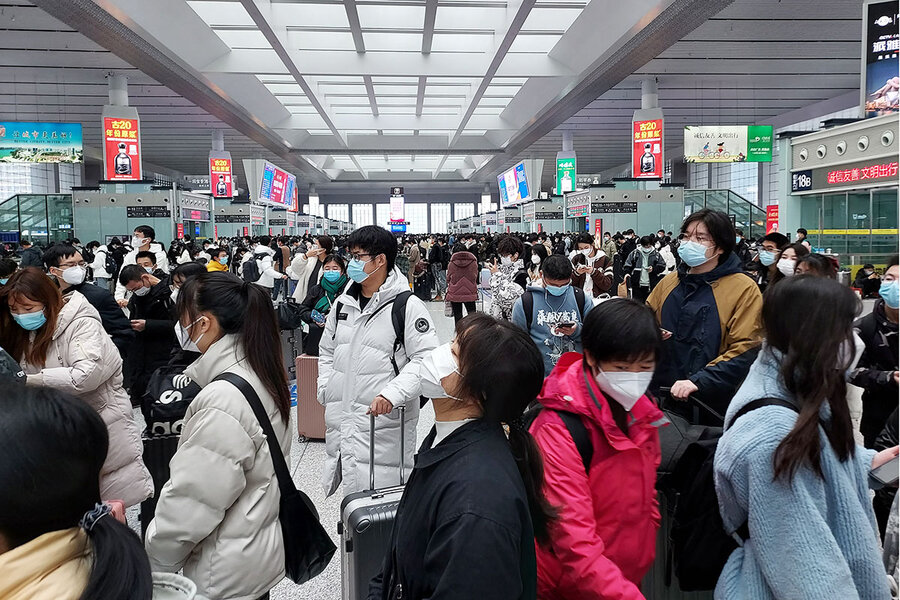China is open for business, but COVID concerns still keep many home
Loading...
| Beijing
In Beijing, officials are working to calm the public and prevent the medical system from being overwhelmed by a rampant COVID-19 outbreak after China lifted many of its strict controls on Dec. 7.
China’s reopening has been touted as an opportunity to rekindle economic growth, revitalize society, and reintegrate with the world after three years of extreme internal controls and isolation. Yet China’s abrupt abandonment of its “zero-COVID” strategy is creating its own challenges. Many restaurants, malls, and movie theaters in the capital reopened this month only to sit deserted, as staff absences halt businesses and many people hunker down at home. Still, experts predict brighter days await the country later next year.
Why We Wrote This
China’s economic revitalization largely hinges on whether the government, which has long touted the dangers of COVID-19, can meet the test of a mass outbreak and assuage public anxieties as controls lift and cases rise.
How China grapples with the next three to six months will prove a major test of the country’s health and governance systems, shaping how strongly it emerges from its COVID-19 endgame.
In terms of economic growth, “we will see things getting worse before they are getting better,” says Larry Hu, chief China economist for the Macquarie Group Ltd., in Hong Kong.
Meanwhile, Li Ang, deputy director of the Beijing Municipal Health Commission, advised people on Tuesday to manage their fears, quoting a Chinese idiom: “Don’t blanch at the mention of a tiger.”
As a sandstorm and frigid winds swept Beijing this week, parents bundling infants in blankets and leading small children by the hand lined up outside a fever clinic. Down the block, other lines formed outside pharmacies, where people made quick purchases and hurried away, gripping bags of herbal medicine.
Scenes like this are playing out across China’s capital in an atmosphere more subdued than celebratory as a COVID-19 outbreak runs rampant following the lifting on Dec. 7 of many of the nation’s strict controls. Restaurants, tea shops, malls, and movie theaters have reopened for business, only to sit deserted.
The unfolding health crisis in the capital underscores how China’s abrupt abandonment of its “zero-COVID” strategy risks creating significant short-term social and economic disruptions, as the country is unprepared for a wave of cases that local experts estimate will impact 840 million people. Indeed, just as the intrusive COVID-19 lockdowns curtailed economic growth and sparked large-scale protests, China’s reopening is causing its own setbacks, as staff absences halt businesses and many people hunker down at home.
Why We Wrote This
China’s economic revitalization largely hinges on whether the government, which has long touted the dangers of COVID-19, can meet the test of a mass outbreak and assuage public anxieties as controls lift and cases rise.
Still, experts predict brighter days await the country later next year. China’s reopening offers opportunities to rekindle economic growth, revitalize society, and reintegrate with the world after three years of extreme internal controls and isolation. But how China grapples with the next three to six months will prove a major test of the country’s health and governance systems, shaping how strongly it emerges from its COVID-19 endgame.
In Beijing, officials are working to calm the public and prevent the medical system from being overwhelmed by what they call an exponential rise in patients. They are opening hundreds of new clinics and appealing to residents not to call the emergency 120 phone line unless the need is dire, after calls surged sixfold last week.
“Do not panic,” Li Ang, deputy director of the Beijing Municipal Health Commission, advised the public Tuesday. People must keep fears in check, he urged, quoting a Chinese idiom: “Don’t blanch at the mention of a tiger.”
Matter of trust
Wearing a black, padded jacket in the subfreezing weather, Vice Premier Sun Chunlan, long the senior enforcer of China’s “zero-COVID” restrictions, visited the epicenter of Beijing’s outbreak on Tuesday with a new message.
Instead of insisting on the “clearing” of every case, she expressed sympathy for front-line medical workers, while conveying “[Communist Party] General Secretary Xi Jinping’s concern and greetings to the people of the capital.”
Apart from brief statements by Ms. Sun saying the danger of COVID-19 has waned, China’s top leaders have remained silent on the dramatic change in pandemic policy, shifting responsibility to national and local health officials. The result is a leadership void when the country needs it most, experts say.
“Now that the leader himself has abandoned zero-COVID … no one wants to be associated with this policy that has obviously failed,” says Donald Low, a public policy expert at the Hong Kong University of Science and Technology. At the same time, he says, “no one dares utter the words ‘live with COVID,’ because they have been opposing that for three years.”
Mr. Xi, who gained a rare third term in October, closely associated himself with the “zero-COVID” policy, hailing it as a demonstration of the superiority of China’s political system over those of the United States and other Western democracies.
China’s persistence until this month with Mr. Xi’s “zero-COVID” approach indicates a lack of policy flexibility that could have drawbacks in other areas, Mr. Low says. Although the policy succeeded in keeping COVID-19 cases and deaths low in China by world standards, its social and economic costs became unsustainable as authorities imposed ever harsher lockdowns to try to contain fast-spreading variants.
“The Chinese state has become far less adaptive, far less responsive, to a fast-evolving situation like a pandemic,” he says.
After widespread protests and mounting cases helped trigger the policy’s end, the overnight lifting of many controls has created public confusion. Adding to the chaotic atmosphere is the growing inaccuracy of official data on cases, as testing declines sharply. Chinese experts are now downplaying the severity of COVID-19, directly contradicting years of propaganda proclaiming its lethality.
“People are skeptical and distrustful of the government,” says Mr. Low.
Travelers rejoice – and worry
At train stations across China last weekend, thousands of college students crammed onto trains to head home – released a month early by their universities so they could avoid getting stuck at school as COVID-19 cases surge.
“Some students were protesting because they were unhappy about the COVID policy,” said one student, who asked to remain anonymous. “Now the schools are sending all the students home early.”
The recent easing of travel controls is one way China’s leaders are shifting their priority from “zero-COVID” to revitalizing the country’s sluggish economy and gross domestic product growth, which has dropped to decades-low levels since 2020, and is only projected to recover to about 3% this year – less than leaders’ stated goal of 5.5%
Many Chinese welcome the lifting of travel restrictions, including the deactivation this week of a national cellphone app that tracked everyone’s movements to determine risk exposure. But as hundreds of millions of Chinese prepare to return to their hometowns next month for the Lunar New Year holiday, many worry about spreading COVID-19 to every corner of the country.
In terms of economic growth, “we will see things getting worse before they are getting better,” says Larry Hu, chief China economist for the Macquarie Group Ltd., in Hong Kong. “For three to six months, we will see disruptions in production and consumption,” he says, as “consumers will feel anxiety” over the outbreak.
It’s an anxiety felt deeply throughout the capital. At one giant shopping mall in Beijing, many stores have seen few customers since reopening last week.
Mr. Xi emphasized at a recent Politburo meeting that China seeks to “significantly boost market confidence,” and signaled Beijing would offer more support to private companies – a move critical to alleviating China’s near-record youth unemployment of around 18%.
The bright spot is that China’s economy is likely to rebound strongly later in 2023, experts say.
“We are expecting 5% growth,” says Mr. Hu.
Seeking stability
Facing the urgent domestic pressures to minimize damage from the current COVID-19 outbreak and restart the economy, experts say China will seek to avoid foreign policy challenges in coming months.
China has “ample incentive to seek a relatively stable external environment,” says Yun Sun, director of the China Program at the Stimson Center in Washington. “The Chinese diplomatic charm offensive is understandable.”
Mr. Xi has recently embarked on a string of overseas trips – to Central Asia, Indonesia, and Saudi Arabia – for a series of meetings with foreign leaders, ending nearly three years during which he made no official international trips.
China has not yet lifted its COVID-19 restrictions that severely limit inbound travelers from overseas, but the Stimson Center’s Ms. Sun expects China’s international exchanges to gradually increase.
“China is mobilizing think tank scholars to go out again and reengage,” she says. Foreign experts are also eager to visit mainland China, she adds, although some may have safety concerns.
Recently, China’s leaders have even been conducting a series of in-person visits with foreign leaders without imposing the usual quarantine requirements.
Chinese Premier Li Keqiang held a face-to-face roundtable with the heads of six international economic organizations – including World Bank President David Malpass and International Monetary Fund Managing Director Kristalina Georgieva – in China’s southern Anhui province earlier this month. “China’s doors will be opened wider,” he promised the group, with leaders planning to “facilitate international exchanges and people mobility” in the coming months.
“China needs the world,” he said, “and the world also needs China.”









